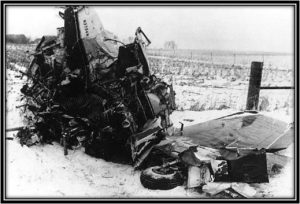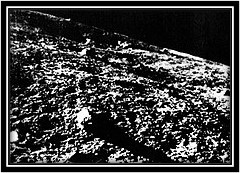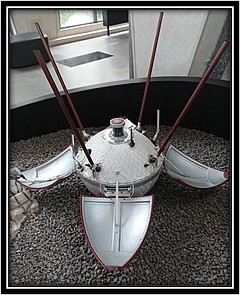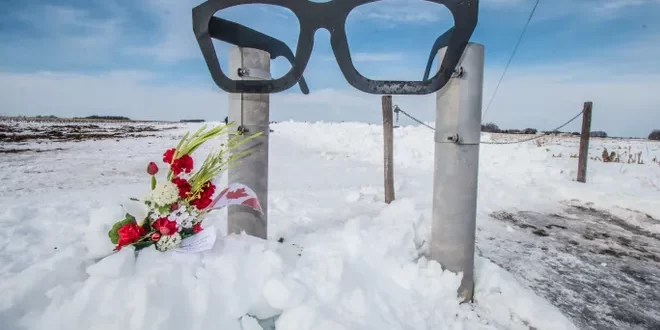A February 3rd Aviation History “Threefer”
Contributor: Barry Fetzer
Sources: History.com. Featured Image via Surf Ballroom and Museum

The Day the Music Died Crash site. Photo Credit: Civil Aeronautics Board.
Today we have a February 3rd aviation history “Threefer”. First up, on this date in 1959, “the music died”. When you consider the ages of these singers, 22, 28, and 17, already successful at such young ages, one might understand how they have, in death, become rock legends.
According to History.com, “Rising American rock stars Buddy Holly, Ritchie Valens, and J.P. ‘The Big Bopper’ Richardson were killed when their chartered Beechcraft Bonanza plane crashes in Iowa a few minutes after takeoff from Mason City on a flight headed for Moorhead, Minnesota. Investigators blamed the crash on bad weather and pilot error. Holly and his band, the Crickets, had just scored a No. 1 hit with ‘That’ll Be the Day.’
“After mechanical difficulties with the tour bus, Holly had chartered a plane for his band to fly between stops on the Winter Dance Party Tour. However, Richardson, who had the flu, convinced Holly’s band member Waylon Jennings to give up his seat, and Ritchie Valens won a coin toss for another seat on the plane.
“Holly, born Charles Holley in Lubbock, Texas, and just 22 when he died, began singing country music with high school friends before switching to rock and roll after opening for various performers, including Elvis Presley. By the mid-1950s, Holly and his band had a regular radio show and toured internationally, playing hits like ‘Peggy Sue,’ ‘Oh, Boy!,’ ‘Maybe Baby’ and ‘Early in the Morning.’ Holly wrote all his own songs, many of which were released after his death and influenced such artists as Bob Dylan and Paul McCartney.
“Another crash victim, J.P. ‘The Big Bopper’ Richardson, 28, started out as a disk jockey in Texas and later began writing songs. Richardson’s most famous recording was the rockabilly ‘Chantilly Lace’, which made the Top 10. He developed a stage show based on his radio persona, ‘The Big Bopper.’
“The third crash victim was Ritchie Valens, born Richard Valenzuela in a suburb of Los Angeles, who was only 17 when the plane went down but had already scored hits with ‘Come On, Let’s Go,’ ‘Donna’, and ‘La Bamba,’ an upbeat number based on a traditional Mexican wedding song. In 1987, Valens’ life was portrayed in the movie La Bamba, and the title song, performed by Los Lobos, became a No. 1 hit. Valens was posthumously inducted into the Rock and Roll Hall of Fame in 2001.
“Singer Don McLean memorialized Holly, Valens and Richardson in the 1972 No. 1 hit ‘American Pie,’ which refers to February 3, 1959 as ‘the day the music died.’”
February 3rd aviation history vignette #2: According to History.com, “On February 3, 1998, a U.S. Marine EA6-B jet flying low over the town of Cavalese in the Italian Alps severed a ski-lift cable, sending a tram crashing to the ground and killing 20 people.
“Cavalese is located in the Dolomite Mountains, about 20 miles northeast of Trento, Italy. In 1976, 42 people there, including 15 children, lost their lives when the cable holding up their ski-lift car snapped.
“On February 3, 1998, 20 Europeans, mostly Germans and Belgians, were taking a ski tram up Cermis Mountain when an EA-6B Prowler operated by the U.S. Marines suddenly flew by. The electronic warfare aircraft sliced right through the steel cable holding up the tram and it plunged more than 250 feet to the ground. Everyone on board was killed instantly.
“The plane suffered minimal damage and returned to its base in Italy. The pilot, Captain Richard J. Ashby, and navigator, Captain Joseph Schweitzer, destroyed a videotape that had recorded their flight before an investigation began. Still, it was soon discovered that the plane had been flying at only 360 feet above the ground, in spite of regulations that set the minimum altitude for flights at 2,000 feet. This revelation spurred large anti-American protests in Italy. President Bill Clinton apologized to the victims’ families and promised compensation, but, pursuant to NATO rules, the U.S. military claimed jurisdiction over the case, despite objections from Italian prosecutors.
“In a military court at Camp Lejeune, North Carolina, Ashby and Schweitzer were charged with involuntary manslaughter and negligent homicide. They claimed that their equipment had malfunctioned and that their maps had not shown the location of the ski-lift. Despite Italian claims that American pilots regularly and intentionally ignored safety regulations to execute risky maneuvers, the crew was acquitted in March 1999. Ashby and Schweitzer were court-martialed for obstruction of justice for their destruction of the videotape and dismissed from the Marines.
“In May 1999, Congress failed to approve a compensation fund for the victims. Italy, however, later approved nearly $2 million dollars in compensation per victim, and, according to NATO regulations, the United States was held liable for 75 percent of the damages.”
“And finally, our February 3rd aviation history vignette #3: On this date in 1966, according to History.com, “The Soviet Union accomplished the first controlled landing on the moon, when the unmanned spacecraft Lunik 9 touches down on the Ocean of Storms. After its soft landing, the circular capsule opened like a flower, deploying its antennas, and began transmitting photographs and television images back to Earth. The 220-pound landing capsule was launched from Earth on January 31st.

The first photo ever taken from the surface of another celestial body. Courtesy Wikipedia.

Lunik 9 model. Courtesy Wikipedia.
“Lunik 9 was the third major lunar first for the Soviet space program: On September 14, 1959, Lunik 2 became the first manmade object to reach the moon when it impacted with the lunar surface, and on October 7 of the same year Lunik 3 flew around the moon and transmitted back to Earth the first images of the far side of the moon. In the late 1950s and early 1960s, the U.S. space program consistently trailed the Soviet program in space firsts—a pattern that shifted dramatically with the triumph of America’s Apollo lunar program in the late 1960s.”







